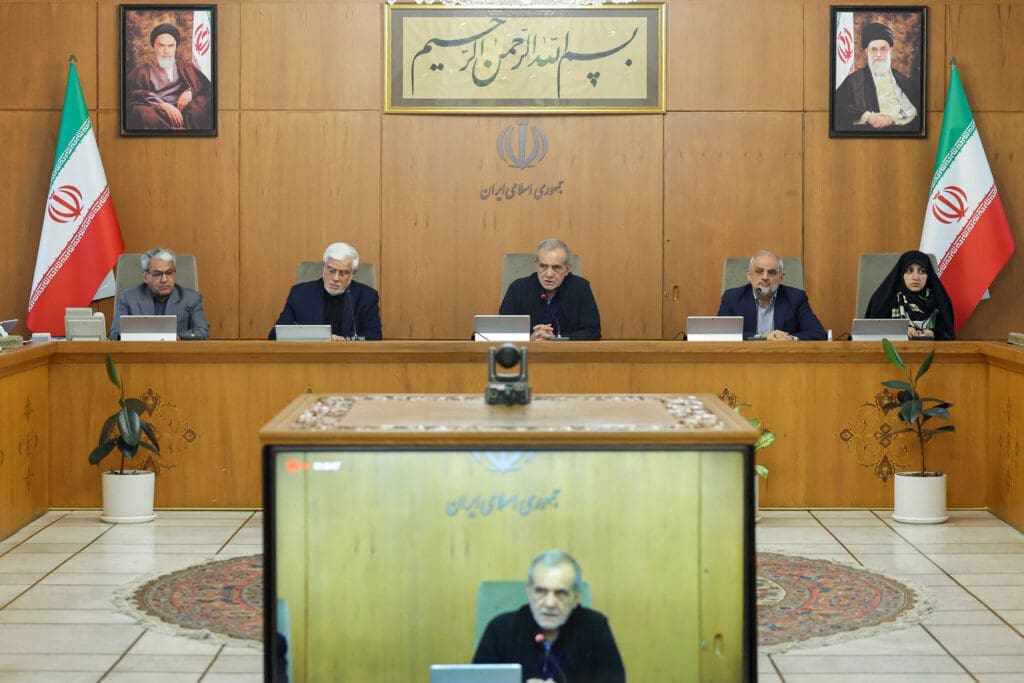Iran’s response to Israel’s unprecedented military offensive has been constrained, reactive and shaped by a growing sense of vulnerability. While it has launched retaliatory strikes, these have been more limited in intensity and scope than many would have anticipated, given Tehran’s massive stockpile of ballistic missiles and drones. This restraint is believed to stem from both operational losses and a broader concern that escalating beyond a certain threshold could trigger U.S. military involvement.
Far from controlling the pace of escalation, Tehran is navigating a conflict not of its choosing, with few favorable options. Its leadership is increasingly under pressure to demonstrate resilience in the face of heavy civilian and military losses, all while avoiding strategic missteps that could spiral into a war it cannot sustain. The logic guiding its actions is not one of dominance, but of survival, i.e., preserving enough capacity and credibility to deter further Israeli escalation and American intervention, contain domestic fallout, and leave room for a possible diplomatic exit.
Deterrence Through Phased Response
Between June 13-16, Iran reportedly launched 11 waves of retaliatory strikes, deploying over 370 ballistic missiles and more than 100 drones. Yet these salvos were phased, limited and tactically constrained. This was not necessarily by choice, but a consequence of damaged infrastructure and the recognition that broader escalation carries existential risks. Iranian analysts acknowledge that Tehran is holding back out of necessity, not merely strategic calculation. Israeli strikes appear to have rendered some major Iranian underground missile bases in the western parts of the country inaccessible or inoperable. Moreover, Israel’s effective dominance over Iranian airspace makes any missile deployment risky and complex.
At the same time, some experts within Iran argue that the Islamic Republic is conserving its capacity not in anticipation of gaining leverage, but because it cannot afford rapid depletion while the prospect of a U.S. strike remains on the table. In other words, it must keep a stockpile on hand to threaten U.S. military installations and other interests in the region.
This interpretation is reinforced by statements from officials such as Foreign Minister Abbas Araghchi, who noted that “only one phone call from Washington can stop” Israeli aggression, suggesting that Tehran still views diplomatic deconfliction channels with the U.S. as viable, even amid active conflict.
Operational restraint also applies to escalation boundaries. Iran has avoided directly targeting U.S. regional assets, though it has permitted affiliated actors like the Houthis to conduct joint operations against Israeli infrastructure. Reports of Iranian drones reaching Eilat and missiles striking Haifa highlight the reach of Iran’s retaliatory capacity, while still stopping short of actions likely to trigger American intervention.
This posture is not purely reactive. Tehran appears to be playing for time, keeping Israel engaged in a war of attrition while deliberately delaying any escalation that might transform the scale of the conflict. The appearance of new weapons systems, such as jet-powered Shahed-107 drones and 1.5-ton warheads used in recent strikes on Tel Aviv, suggests that Iran still possesses significant offensive capabilities, but is metering their use in line with broader strategic considerations.
Nuclear Ambiguity and Legal Shielding
Despite the destruction of surface-level centrifuge halls at Natanz and damage to other key facilities, Iran has refrained from withdrawing from the Nuclear Non-Proliferation Treaty (NPT) or expelling IAEA inspectors. Hardline figures in parliament have openly called for such measures, yet Iran’s leadership appears to view continued NPT participation as strategically protective.
The logic is straightforward: As long as inspectors remain in the country and Iran does not formally exit the treaty, Israel and its allies lack a clear legal or diplomatic basis for asserting that Iran’s nuclear program has crossed into weaponization. Additionally, Tehran’s assertion that Israel’s attacks violate international law absent an imminent threat would be weakened by any move that signals intent to pursue a nuclear breakout.
There are also technical reasons for restraint. Exiting the NPT without a fully operational weaponization infrastructure, including warhead assembly and reliable delivery systems, would risk triggering a full-scale preemptive strike without producing a credible deterrent in return. Moreover, current wartime conditions are poorly suited for covert advances in weaponization. Heightened surveillance, intelligence penetration and aerial dominance make concealment increasingly difficult.
The result is a posture of calculated ambiguity: Iran preserves the option to leave the treaty but avoids doing so unless pushed beyond its own red lines. While IAEA inspections are currently paused for safety reasons, their presence still functions as a diplomatic tripwire, making any future strike on sites like Fordow—considered Iran’s most protected nuclear facility—more politically and legally complicated.
Civilian Costs and the Politics of Panic
The most visible dimension of the war, however, lies not in missiles or enrichment, but in the civilian toll. Israeli strikes over the past several days have killed more than 220 Iranian civilians, damaged hospitals (such as Farabi Hospital in Kermanshah), disrupted power grids across Tehran, and significantly damaged the headquarters of the state media broadcaster, IRIB. The scope and pattern of these attacks suggest a shift toward what Iranian analysts consider the “socialization” of war: A deliberate effort to generate public pressure on the regime by targeting symbolic and civilian infrastructure.
Netanyahu’s government has issued evacuation warnings in Tehran, mirroring tactics previously used in Gaza and Lebanon, while heavily attacking civilian infrastructure in the hope of putting pressure on the Iranian government. Yet, contrary to Israeli expectations, these actions have not triggered mass unrest or a political rupture within the Islamic Republic. Even figures from the reformist and opposition camps, such as political prisoner Mostafa Tajzadeh, have condemned the Israeli strikes, while others, like Narges Mohammadi, have called for nuclear concessions to end the war. The result is not mass mobilization, but a kind of ambient dread: fear without uprising.
Still, Iranian officials remain deeply concerned about what may follow. There is no evidence of separatist mobilization, but internal security bodies appear increasingly alarmed by the potential for armed rebellion, localized insurgency or sabotage by infiltrated networks. The unprecedented nature of the attacks and the depth of Israeli intelligence penetration, as revealed by bombings and sabotage operations in Tehran, has partly shifted the government’s focus toward preempting internal disruption.
This is why, despite widespread panic in Tehran and growing civilian hardship, the state has avoided framing the war as one of regime survival. Instead, the dominant narrative emphasizes sovereignty, resilience and proportionate response—not collapse, revolution or total war. The government’s decision to keep the metro stations open 24 hours a day for civilian shelter, and to ensure that ministries continue functioning even under attack, reinforces this message.
Iran’s current strategy is not defined by battlefield dominance, but by shaping the enemy’s perception. The leadership understands that time is not neutral, but it favors the side that can sustain pressure without fracturing. From this perspective, every day that Iran endures Israeli strikes without drawing in the United States is seen as a political victory. Every restrained retaliatory act serves as strategic messaging that Iran is not defeated, it is not isolated, and it is capable of inflicting pain on the other side.
At the same time, Iranian officials insist that a diplomatic path remains open, but not unconditionally. They have reportedly told Omani and Qatari intermediaries that any talks must follow, not precede, the completion of their military response. This sequencing reflects the regime’s core dilemma: Re-entering talks too soon could be perceived as capitulation; waiting too long risks escalation beyond its control. Araghchi’s remarks, Trump’s public support for Israel, and Israeli officials’ open threats to target Supreme Leader Ali Khamenei all underscore the thin margins Tehran must navigate.
Whether this balancing act can be sustained remains deeply uncertain. Direct U.S. involvement, such as a strike on Fordow, could unravel Iran’s current posture. Yet even in that scenario, there is little indication that Iran would move immediately toward capitulation. More likely, it would seek to widen the battlefield: targeting U.S. military bases in Iraq and the Persian Gulf, activating allied militias, or striking energy infrastructure and shipping routes to disrupt the global flow of oil and gas. The objective would not be to win a conventional war, but to raise the cost of escalation for all parties and position itself more favorably for eventual negotiations.
For now, Tehran’s actions reflect a state under siege: improvising under pressure, avoiding miscalculation and preserving enough capability to shape—not dictate—whatever political outcome follows. Given what is at stake, sustained international diplomatic involvement, particularly from actors with influence over both Tehran and Tel Aviv, is not merely desirable, but urgently necessary to prevent the conflict from spilling into a broader regional conflagration.


